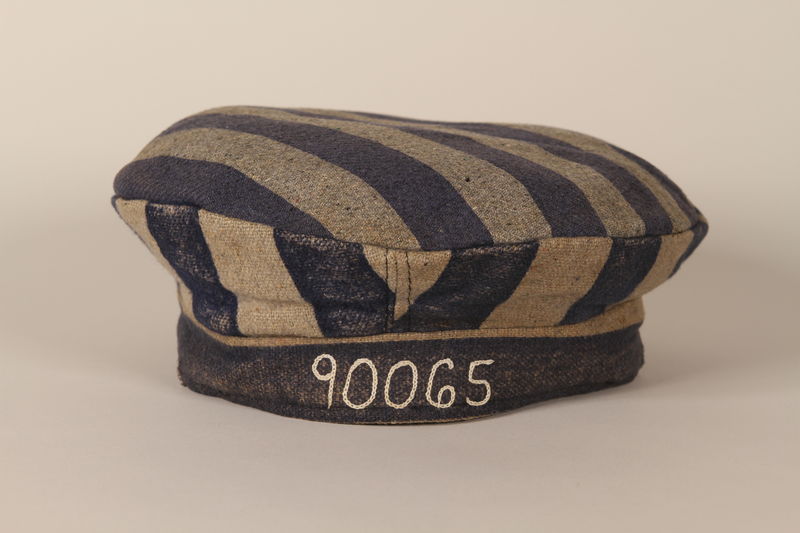Overview
- Brief Narrative
- Striped concentration camp uniform cap worn by Henryk Karter while a prisoner in Auschwitz I, II, and III concentration camps from December 1942-January 1945. It has his prisoner number 90065 embroidered on the front. Armband with a red cross worn by Henryk Karter while a prisoner and nurse in Block 19, the hospital, in Auschwitz I concentration camp, from ca. 1943 until his liberation in January 1945. Henryk, wife Edith, and children Jurek, 3, and Halina, 5 months, fled Bielsko, Poland, for Krakow during the German invasion in September 1939. In June 1941, the family was forced into the Krakow ghetto. In late 1941, Henryk was arrested for resistance activity by the Gestapo. In December 1942, he was sent to Auschwitz-Birkenau as a political prisoner and tattooed with the number 90065. In February 1943, he was sent to Auschwitz III-Monowitz (Buna). After six months, he became ill and was sent to Auschwitz I to be gassed. He was saved by a guard and eventually assigned to the hospital block. When Auschwitz was evacuated on January 18, 1945, Henryk remained behind. On January 27, Soviet forces entered the camp. Henryk returned to Bielsko with three young boys he had protected at the camp. He found family members for two of the boys, and adopted, Jakub, 12. Henryk remarried and the family left for America in 1947. Nearly Henryk’s entire family, about seventy people, was murdered in the Holocaust.
- Date
-
use:
1942 December-1945 January
- Geography
-
use:
Birkenau (Concentration camp);
Brzezinka (Wojewodztwo Ma‚opolskie, Poland)
use: Monowitz (Concentration camp); Monowice (Poland)
use: Auschwitz (Concentration camp); Oświęcim (Poland)
- Credit Line
- United States Holocaust Memorial Museum Collection, Gift of the American Jewish Archives on behalf of Henry Carter
- Contributor
-
Subject:
Henry Carter
- Biography
-
Henryk Karter was born April 12, 1908, in Dankowice, Austria-Hungary (now Poland), to Salomon (Samuel) and Rozia Karter. He had 6 siblings: Adolf, Gustav, born August 28, 1901, Wilhelm, Sali, Josephine, and Marta. Their father Salomon was born circa 1867. He was a farmer and owned a country store. They were the only Jewish family in Dankowice. There was no synagogue, but the family celebrated Shabbat at home. Henryk attended a German grade school, then a Polish school, and was fluent in German and Polish. Henryk attended business school for two years and graduated in 1930. He worked for his brother Gustav, who owned a machine store in Cieszyn. The brothers became business partners and opened two more stores, which sold farm machines, sewing machines, and bicycles. In 1935, Henryk married Edith Lanzer, who was born May 19, 1910, in Dittmannsdorf, Czechoslovakia, Austria-Hungary, (now Detmarovice, Czech Republic) to Yosef and Miriam Lantzer. They had two children: Georg (Jurek), born April 10, 1936, and Helene (Halina), born May 25, 1939. The family lived in Bielsko (now Bielsko-Biala).
On September 1, 1939, Germany invaded Poland. Gustav was in the US to attend the World’s Fair, and was unable to return. Henryk was in the Polish Army, but left to get his family and flee east. They went to Bochnia, then to Krakow, where they rented an apartment. The Germans made Krakow the capital of this occupied region, called the Generalgouvernement. Henryk was forced to build roads for Organization Todt, a German construction battalion. He had a second job making bicycle chains. In June 1941, Henryk and his family were forced to move into the ghetto. One day, Henryk saw a man he knew from Bielsko on the street, Wilhelm Stosch, a German salesman from Berlin. Stosch was the Secretary of Electricity in the occupation government and got Henryk papers signed by the governor, which said that Henryk did not have to wear a Star of David badge and was free to move around the city. Without the badge, he could use the streetcar and enter businesses that forbid Jews. In exchange, Henryk purchased food for Stosch from the black market. Stosch also allowed Henryk to listen to British radio broadcasts, and Henryk passed the information to the resistance. A resistance member was caught who named Henryk as part of the underground, and he had to flee. He lived in hiding outside the ghetto and briefly in the woods. In late 1941, Henryk was arrested when he was visiting his family in the ghetto. He was taken to Montelupich prison, a Krakow jail used by the Gestapo. He was tortured for information about others in the resistance, but he refused to admit that he was in the underground. In May 1942, he was taken to the ghetto jail. Henryk and the other prisoners tried to escape by digging their way out, but were caught and severely punished.
In December 1942, Henryk was sent to Auschwitz-Birkenau concentration camp as a political prisoner. He was issued a striped uniform with a red political prisoner badge and tattooed with prisoner number 90065. The sanitary conditions were terrible. Henryk survived by stealing food, which he shared with other prisoners. Henryk and other healthier prisoners were forced to look for sick prisoners who tried to hide, so they could be sent to the gas chambers. Around February 1943, there was a selection. The prisoners had to strip and be inspected. An SS officer asked for mechanics, so Henryk lied and said he was a mechanic. The next day, he was taken to Buna, a factory in Auschwitz III-Monowitz. He was assigned to carry steel and cement. Henryk also guarded the electric fence to prevent prisoners from committing suicide by touching the wires. After about six months, Henryk got sick and was sent to the hospital in Auschwitz I. There was a selection and men with fevers were sent to the left to go to the gas chambers. Henryk was sent to the left, but a guard, whom Henryk had known in Krakow, saved his life by hitting him and yelling that he was supposed to be on the right. Henryk reported to this assigned block and tried to speak to the kapo. The kapo hit Henryk and he fell from the second floor to the first. A prisoner took him to the basement, where he worked sorting potatoes. He was given no rations. After a few days, a different kapo came into the basement to take some potatoes. Henryk had known the man in Cieszyn, and this man, with another kapo, took Henryk to his block. Henryk was given soup and worked peeling potatoes. After three weeks, Henryk recovered and was sent to the second kapo’s block, where he worked with cement. The kapo taught Henryk to exercise with pieces of cement to get stronger. When the SS searched for weak prisoners to take to the gas chambers, the kapo hid Henryk in the basement.
Eventually, Henryk met a doctor from Cieszyn, who offered to get Henryk a job as a nurse in the hospital block. He took Henryk into the hospital as a patient. When the SS came to take people to the gas chamber, the doctor put Henryk in the room with typhus patients, which the SS would not enter. He saved Henryk again by putting him in the bathroom and telling the SS he was fixing the toilet. Henryk was trained as a nurse, then worked in Block 19, the Schonungsblock for convalescent prisoners. Henryk saved younger Jewish boys who came to the hospital by telling them the block was full so they would not be admitted and then taken to the gas chambers. Dr. Klein was eventually put in charge of the block. The SS came to take all the patients to the gas chambers and Dr. Klein forced Henryk and the other nurses to load them onto the trucks. Dr. Klein put any nurse who looked upset on the trucks, too. One boy jumped off the truck and begged Dr. Klein to spare him, but he beat him on the head. In January 1945, Soviet troops were approaching Auschwitz and the camp was evacuated on January 18. The SS guards asked a nurse and a doctor to stay behind, and Henryk stayed. Some SS guards remained behind to destroy evidence, so Henryk decided to hide with two friends and three young boys he protected. They boarded themselves in beneath the stairs in one block. They had no sanitary facilities and the boys wanted to leave, but they could hear shooting and Henryk insisted that they stay. After two days, on January 27, Soviet soldiers arrived at the camp.
Henryk and the three boys were taken to Krakow by Soviet soldiers. Henryk heard that everyone in the Krakow ghetto had been murdered and knew that his wife and children were dead. He lost almost his entire family, 69 people, including his parents, siblings, nieces, nephews, aunts, uncles, and cousins. His brother Gustav’s wife Anna, and their two children were deported to Siberia by Soviet forces. Anna died of starvation, but both children survived and were brought the US by their father. After a few months, Henryk and the boys from Auschwitz went to Bielsko. Henryk reopened his store. He looked for the boys’ families and found relatives for two of them. The third, Jakub, 12, had no surviving relatives, so Henryk adopted him. Jakub was from Bielsko, where he was born October 3, 1932. His prisoner number in Auschwitz was 125434. Henryk married Anna Feld Kornblueth, born March 2, 1909, in Skawina, Poland, to Sigmund and Sara Feld. She survived Krakow ghetto and Auschwitz and Ravensbrück concentration camps. Her daughter, Alina Kornblueth (1934-2005), from her first marriage, survived in hiding with a Christian family, but her son perished in the camps. Henryk and Anna had a daughter, Ruth. In 1946, the family moved to Prague. On July 13, 1947, Henryk and Jakub left for America from Le Havre, France, aboard the SS Marine Falcon, arriving in New York on July 23. They Americanized their names to Henry and Jack Carter. They settled in Cincinnati, Ohio, near Henryk’s brother Gustav. Anna, Alina, and Ruth later joined them. Henry opened a store in Erlanger, Kentucky. Gustav, 71, died on January 16, 1973. Anna, 91, died on May 16, 2000. Henry, 97, died on May 6, 2005.
Physical Details
- Classification
-
Clothing and Dress
- Category
-
Concentration camp uniforms
- Object Type
-
Caps (Headgear) (lcsh)
- Physical Description
- Blue and gray striped wool brimless cap lined with satin weave brown cloth. A 2.5 inch panel connects the headband and the flat, circular crown, which gives the cap height and shape. The side, headband, and crown are made from a different blue and gray striped wool cloth. The headband has 2 small vertical scissor cuts and a back seam was opened, probably to make it fit better. The number 90065 is chain stitched in white thread on the front of the headband. The cloth is discolored and the side panel is fuzzy, chiefly on the right, from wear.
- Dimensions
- overall: Height: 2.875 inches (7.303 cm) | Width: 8.750 inches (22.225 cm) | Depth: 8.875 inches (22.543 cm)
- Materials
- overall : wool, cotton, thread
Rights & Restrictions
- Conditions on Access
- No restrictions on access
- Conditions on Use
- No restrictions on use
Keywords & Subjects
- Topical Term
- Concentration camp inmates--Medical care--Poland--Oswiecim--Biography. Concentration camp inmates--Poland--Biography. Holocaust survivors--United States--Biography. Holocaust, Jewish (1939-1945)--Poland--Personal narratives. Nurses--Poland--Oswiecim--Biography. World War, 1939-1945--Underground movements--Poland--Personal narratives.
Administrative Notes
- Legal Status
- Permanent Collection
- Provenance
- The cap was donated to the United States Holocaust Memorial Museum in 1993 by the American Jewish Archives, on behalf of Henry Carter.
- Funding Note
- The cataloging of this artifact has been supported by a grant from the Conference on Jewish Material Claims Against Germany.
- Record last modified:
- 2022-07-28 18:22:21
- This page:
- https://collections.ushmm.org/search/catalog/irn8388
Also in Henry Carter collection
The collection consists of an armband, a concentration camp uniform jacket, pants, and cap, and a commemorative pin relating to the experiences of Henryk Karter (later Henry Carter) while a prisoner in Auschwitz I, II, Auschwitz-Birkenau, and III, Auschwitz-Monowitz (Buna) concentration camps in German occupied Poland during the Holocaust and in the United States after the Holocaust.
Date: 1942 December-approximately 1946
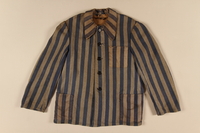
Concentration camp uniform jacket worn by a Polish Jewish inmate
Object
Striped concentration camp uniform jacket worn by Henryk Karter while a prisoner in Auschwitz I, II, and III concentration camps from December 1942-January 1945. Henryk, wife Edith, and children Jurek, 3, and Halina, 5 months, fled Bielsko, Poland, for Krakow during the German invasion in September 1939. In June 1941, the family was forced into the Krakow ghetto. In late 1941, Henryk was arrested for resistance activity by the Gestapo. In December 1942, he was sent to Auschwitz-Birkenau as a political prisoner and tattooed with the number 90065. In February 1943, he was sent to Auschwitz III-Monowitz (Buna). After six months, he became ill and was sent to Auschwitz I to be gassed. He was saved by a guard and eventually assigned to the hospital block. When Auschwitz was evacuated on January 18, 1945, Henryk remained behind. On January 27, Soviet forces entered the camp. Henryk returned to Bielsko with three young boys he had protected at the camp. He found family members for two of the boys, and adopted, Jakub, 12. Henryk remarried and the family left for America in 1947. Nearly Henryk’s entire family, about seventy people, was murdered in the Holocaust.
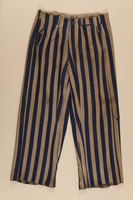
Concentration camp uniform pants worn by a Polish Jewish inmate
Object
Striped concentration camp uniform pants worn by Henryk Karter while a prisoner in Auschwitz I, II, and III concentration camps from December 1942-January 1945. Henryk, wife Edith, and children Jurek, 3, and Halina, 5 months, fled Bielsko, Poland, for Krakow during the German invasion in September 1939. In June 1941, the family was forced into the Krakow ghetto. In late 1941, Henryk was arrested for resistance activity by the Gestapo. In December 1942, he was sent to Auschwitz-Birkenau as a political prisoner and tattooed with the number 90065. In February 1943, he was sent to Auschwitz III-Monowitz (Buna). After six months, he became ill and was returned to Auschwitz I to be gassed. He was saved by a guard and eventually assigned to the hospital block. When Auschwitz was evacuated on January 18, 1945, Henryk remained behind. On January 27, Soviet forces entered the camp. Henryk returned to Bielsko with three young boys he had protected at the camp. He found family members for two of the boys, and adopted, Jakub, 12. Henryk remarried and the family left for America in 1947. Nearly Henryk’s entire family, about seventy people, was murdered in the Holocaust.
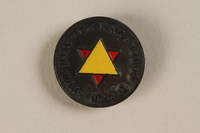
Star of David membership pin owned by a former concentration camp inmate
Object
Star of David lapel pin owned by Henryk Karter identifying him as a member of an association of former Nazi prisoners based in Israel. Henryk, wife Edith, and children Jurek, 3, and Halina, 5 months, fled Bielsko, Poland, for Krakow during the German invasion in September 1939. In June 1941, the family was forced into the Krakow ghetto. In late 1941, Henryk was arrested for resistance activity by the Gestapo. In December 1942, he was sent to Auschwitz-Birkenau as a political prisoner and tattooed with the number 90065. In February 1943, he was sent to Auschwitz III-Monowitz (Buna). After six months, he became ill and was returned to Auschwitz I to be gassed. He was saved by a guard and eventually assigned to the hospital block. When Auschwitz was evacuated on January 18, 1945, Henryk remained behind. On January 27, Soviet forces entered the camp. Henryk returned to Bielsko with three young boys he had protected at the camp. He found family members for two of the boys, and adopted, Jakub, 12, after his marriage to a Holocaust survivor, Anna Feld Kornblueth. The family left for America in 1947. Nearly Henryk’s entire family, about seventy people, was murdered in the Holocaust.Henry later emigrated to the United States.
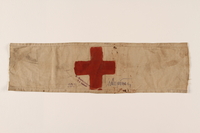
White armband with a red cross worn by a concentration camp inmate
Object
Armband with a red cross worn by Henryk Karter while a prisoner and nurse in Block 19, the hospital, in Auschwitz I concentration camp, from ca. 1943 until his liberation in January 1945. Henryk, wife Edith, and children Jurek, 3, and Halina, 5 months, fled Bielsko, Poland, for Krakow during the German invasion in September 1939. In June 1941, the family was forced into the Krakow ghetto. In late 1941, Henryk was arrested for resistance activity by the Gestapo. In December 1942, he was sent to Auschwitz-Birkenau as a political prisoner and tattooed with the number 90065. In February 1943, he was sent to Auschwitz III-Monowitz (Buna). After six months, he became ill and was returned to Auschwitz I to be gassed. He was saved by a guard and eventually assigned to the hospital block. When Auschwitz was evacuated on January 18, 1945, Henryk remained behind. On January 27, Soviet forces entered the camp. Henryk returned to Bielsko with three young boys he had protected at the camp. He found family members for two of the boys, and adopted, Jakub, 12, after his marriage to a Holocaust survivor, Anna Feld Kornblueth. The family left for America in 1947. Nearly Henryk’s entire family, about seventy people, was murdered in the Holocaust.

